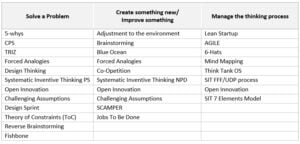Imagine a chef, who only uses a spoon.
Imagine a dentist, who only uses a drill.
Imagine an innovation professional, who only uses one method or one tool…
Innovation professionals are expected to have several tools in their innovation toolbox. They are expected to be able to choose the right tool for the job and to demonstrate proficiency in applying it. Hence my surprise, when talking with innovation professionals, to find that most of them focus on a single tool or a method.
This article is a response to that.
The goal is to match the most widely used innovation techniques and tools with the scenarios where they excel. My motivation is to encourage readers to explore and experiment in order to improve and enhance their innovation toolbox.
It is important to say that I have picked the tools and methods that I am familiar with, and that I placed them in the table based on data, essays, and testimonials I found on the web AND based on my own personal experience. Obviously, this is an on-going iterative process that would benefit from more inputs and periodic updates.
Since we are focusing on innovation, I would like to make a distinction between NEW and INNOVATIVE. While all innovations are new, not everything new can be considered innovative. In my opinion, true innovation requires the new idea, product, or service to introduce original processes or thinking that disrupt existing practices in a good way. In recent years there is a growing number of models that help assess and ‘measure’ the level of creativity and inventiveness to help rate the quality of the outcomes of an innovation process. These models are used to help differentiate between new (and good/smart/big/….) ideas and innovative ideas.
The full list of tools and methods I have collected can be accessed here, or write me a note and I will share it with you.
Although we can identify many different types of applications, it is most practical to focus on the following clusters for innovation tools.:
- Inventing or improving– when we wish to create something totally new, that will be very different from what we (or others) can invent, without using a tool. It is also true for improving an existing situation (or product or process or system…) – the current situation is working well, yet we wish to make it even better.
- Solving a Problem – When something worked in the past but now its “broken”, and we need to get it back to work at least as good as it used to, if not better.
- Managing the Thinking Process – we assume that if you group together a team and let them think together, the outcome will exceed results of the same individuals thinking separately. This is, of course, very wrong. People have different thinking dispositions, thinking styles and fixedness. To get optimal results we need to manage the thinking process. There are some tools designed exactly for that. (if you wish to learn more, please read here).
Not included in this article are:
Good PR but not innovation – there are many good and effective methods and processes out there, that proved themselves useful in creating business or organizational value. Many of them are positioned as innovation tools, although have little to do with the way we create original, unique, and effective value. We will list those tools and methods separately.
Innovation Management platforms – most of these platforms are sophisticated Excel sheets or digital repositories that collect and share ideas. Obviously, it has very little effect on the type and quality of the ideas captured by these systems.
After completing the list, I tried to answer the following questions:
- In what way it affects the thinking process and/or the results?
- How it performs compared to other alternatives?
Out of the 164 listed tools and methods, and based on the definitions, clusters and logic presented earlier, I was able to map, “so far”, 31 tools in the table below. I created the table based on over 20 years of experience, knowledge, and expertise, as well as on inputs and testimonials of clients, colleagues, and competitors.

For me, there are 3 main conclusions from this review:
- This table presents a very good and diverse toolbox. I am sure that most innovation professionals would be able to find the right tool combination for their needs.
- As you can see above, there are only a handful of tools and methods that meet both with the criteria set above and were tested and compared with other alternatives. I am sure that if we keep evaluating and testing, we will be able to add more tools and methods.
- We all have favorites! Some of the tools here are my obvious choice when I need to deliver results, and some are methods that I don’t like to use. Nevertheless, at the end of the day we should be able objectively and professionally justify our preferences.
I would love this article to start a conversation and a communal effort. This table should be dynamic rather than static. Hopefully some of you will join me to turn this into a live project, where we all contribute to create better toolboxes and develop professional standards.
What tools would you add or remove from this list? Why?
Would like to join this initiative and collaborate?
